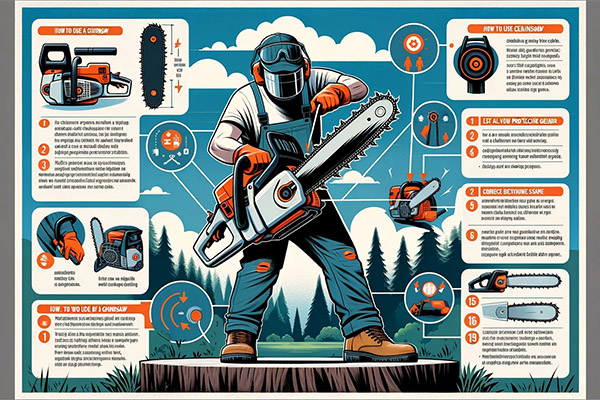The chainsaw, an engineering marvel, effortlessly slices through even the toughest timber. However, this remarkable power also demands reverence and vigilance. The chainsaw’s raw, unbridled strength allows it to sculpt and mold wood with unmatched precision. Yet, this same potency harbors the potential to become a dangerous weapon if handled carelessly. In the following pages, we will embark on an exploration of chainsaw operation, fusing the knowledge passed down by seasoned professionals with vital safety measures. Our aim is not only to help you attain mastery over this formidable tool but also to ensure that you wield it with the utmost efficiency and safety at the forefront of your mind.
Understanding the Chainsaw:
Before delving into the specifics of chainsaw use, let’s get acquainted with the beast itself. The chainsaw, a portable powerhouse, features a swiftly rotating chain that whirls around a guide bar. It is the go-to tool for tasks like pruning, felling, limbing, and bucking trees, making it indispensable in the realm of forestry and woodworking.
However, this power comes at a price, as the chainsaw ranks among the most perilous power tools available without requiring a license. The danger lies primarily in the “kickback zone,” which is the top half of the end tip of the blade. Anything coming into contact with this region can disrupt the cutting momentum, causing the chainsaw to recoil unpredictably, often with devastating consequences.
Essential Safety Measures:
Safety should always be your top priority when wielding a chainsaw. Whether you’re a seasoned pro or a novice, consider these fundamental safety tips:
- Maintain Chain Sharpness and Tension: A sharp and well-tensioned chain minimizes the risk of kickback. Always ensure your chainsaw is in optimal cutting condition.
- Keep Cutting Below Shoulder Height: Maintain control by cutting below shoulder height whenever possible. This stance enhances your ability to manage the chainsaw effectively.
- Choose the Right Chainsaw: Modern chainsaws, even electric models, are equipped with low-kickback chains that enhance safety. Select the appropriate chainsaw for your needs to reduce the risk further.

Before You Begin:
Now that you’re armed with essential safety knowledge, let’s delve into the step-by-step process of using a chainsaw safely and effectively.
Step 1: Never Operate Alone
Chainsaw work is never a solo endeavor. Accidents can occur swiftly, and having a companion nearby can be a lifesaver. If you’re venturing into remote areas, ensure someone is aware of your whereabouts and has a clear timeline of your return.
Step 2: Gear Up for Protection
Prioritize personal protective equipment:
- Wear chaps to safeguard your legs
- Don a chainsaw helmet with a face guard
- Put on protective gloves
- Wear steel-toed or logging boots
- Avoid loose clothing that could become entangled in the chainsaw’s moving parts.
Step 3: Find Your Stance
Maintain a stable and comfortable stance with both feet firmly planted. Hold the chainsaw with both hands and position it slightly to one side, minimizing the risk of injury in case of kickback.
Step 4: Think Before You Cut
Never use a chainsaw on a ladder or cut limbs higher than shoulder level. Be vigilant about power lines, vehicles, buildings, and people within a safe distance.
Step 5: Choose the Right Chainsaw
Select a chainsaw size that matches your job requirements. The blade should be two inches longer than the wood you intend to cut. Novices should opt for blades less than 20 inches for better control.
Step-by-Step Chainsaw Operation:

Step 1: Familiarize Your Workspace
Scan your work area and identify potential escape routes. Chainsaws are powerful tools, so understanding your terrain is crucial for safe operation.
Step 2: Prepare Yourself and Your Saw
Ensure you’re wearing the proper personal protective equipment and that your chainsaw’s chain is properly tensioned. For gas-powered chainsaws, check the fuel level and mix the gas and oil as directed.
Step 3: Maintain the Depth Gauges
For gas-powered chainsaws, fill the gas tank using the recommended gas-to-oil ratio. Also, fill the chain lube reservoir with the appropriate chain oil.
Step 4: Engage the Chain Brake
Lock the chain brake to prevent the chain from spinning until you’re ready to begin cutting.
Step 5: Choke and Prime the Saw
If using a gas-powered chainsaw, turn on the choke and prime the saw. For electric chainsaws, simply engage the safety switch and power on the tool.
Step 6: Start the Saw Securely
Gas chainsaw users should secure the saw with their foot and pull the starter rope. Electric chainsaw users can skip this step.
Step 7: Maintain Proper Positioning
Stand with a firm grip and engage the throttle when ready to cut. Always cut to the side to minimize injury in case of kickback.
Step 8: Execute the Cut
Release the chain brake and fully engage the throttle. Let the chain’s momentum do the cutting; avoid forcing it. Be mindful of the cord if using an electric chainsaw.
Step 9: Complete the Cut
Maintain a strong grip and throttle until the cut is finished. Release the throttle only after removing the blade from the cut.
Step 10: Shut Down and Store the Saw
Turn off the chainsaw and allow it to cool before storing. Gas chainsaw users should consider leftover fuel, either using it within four weeks or draining it safely.
In summary, achieving expertise in chainsaw operation involves more than just efficiency; it’s primarily about ensuring safety. Proper saw maintenance, including regular chain tension checks and diligent sharpening, is fundamental to keeping the tool in optimal condition. Safety must be the top priority, and these guidelines should be followed with unwavering caution, recognizing the formidable power of chainsaws.
